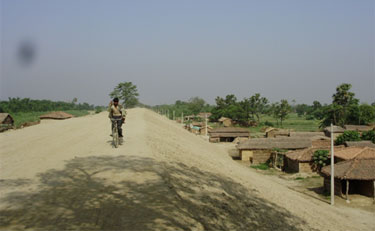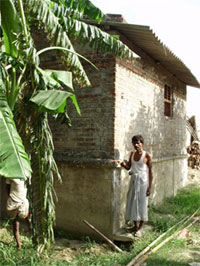 The Bagmati Embankment separating riverside on the left and countryside of the right near Ibrahimpur – Electric poles suggest the height of the embankment
The Bagmati Embankment separating riverside on the left and countryside of the right near Ibrahimpur – Electric poles suggest the height of the embankment
One often hears about the civilizations buried under earth and attributes various reasons for such disappearance of life from a particular place. Excavations reveal the way of life the people might have had before they chose to leave their villages and towns and allowed the nature to take its own course. These accounts are available in books and we all believe the process told to us by historians and archaeologists. These are all conjectures that are revealed by scientific investigations but how many of us have seen, not read, how the civilizations get buried under the debris created by nature? There are places in Bihar where one can see the process of disappearance of civilization and the villages getting buried under the sediments brought by rivers.
A massive program in the name of flood control was undertaken in North Bihar in late 1950s to tame the rivers with heavy charge of sediments by constructing embankments along them to prevent their spilling. With the jacketing of the river, the bed level of the river started rising because the embankments, while preventing the flood-waters of the river to escape, prevented the spreading of the sediments on the countryside and stopped the natural land building process of the rivers and this process is now restricted to the space within the embankments that are separated by a distance of 2-3 kilometres in case of the Mahananda, Kamala and the Bagmati Rivers to about 10-16 kilometres in case of the Kosi. It is customary to construct houses over the debris of the earlier house in case of its collapse in the flood prone areas of the country but this process is highly accelerated within the embankments along the rivers.
 Nagendra Paswan of Ibrahimpur standing on the Chajja of his old house within the embankments
Nagendra Paswan of Ibrahimpur standing on the Chajja of his old house within the embankments
Let us visit some of the villages in the Bagmati basin of Bihar to have a feel of disappearance of human settlements and systematic burial of their assets under earth. Ibrahimpur village in the Runni Saidpur block of Sitamarhi district of Bihar is a case in point. This village was trapped between the two embankments along the rivers constructed in late 1970s. Some families of the village were given rehabilitation in the protected countryside of the embankments but the majority of them preferred to stay back within the embankments because their agricultural land was there and it was not possible for them to handle agricultural operations from their rehabilitation sites. As of now, there may be around 200-250 families in the rehabilitation site while those living between the river and the embankments are around 400. Because of sedimentation, the land within the embankments is about 15 feet higher than the adjoining countryside now. The height of the embankment may be another 8 feet above that level. Thus, the level difference between the countryside and the crest of the embankment may not be less than 23 feet in any case.
Says Nagendra Paswan of Ibrahimpur, ‘…Those living within the embankments have to build their house almost every year as it gets eroded, washed away or sunk partially in sand. Only good thing about us is that unlike the so-called protected countryside, our lives are not lost as the villagers know how to deal with a naughty river like the Bagmati. We don’t have to face breaches. There is temple of Lord Shiva in our village. When the river rises during the rainy season, its waters enter the temple but when the river recedes, the temple gets filled till half its height with sand that has to be excavated to get the image out for worshipping and performing rituals. Receding river does the same thing to our houses also. You can see my earlier house sunk in sand till lintel level and I am building the first floor but that would be the ground floor of my house’.